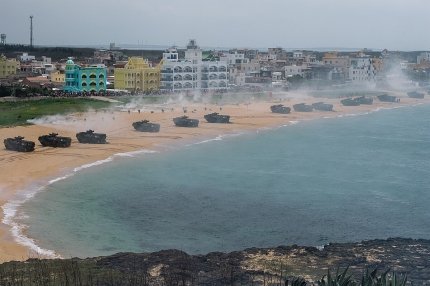As military analyst David Axe notes, China is building special landing barges to transport military equipment and personnel in possible preparations for an invasion of Taiwan.
Points of attention
- China is building landing barges for a potential invasion of Taiwan, utilizing civilian vessels for military purposes.
- Chinese military power in the Pacific, particularly in aviation, is growing, posing a challenge to the United States.
- Analysts suggest that China would need to transport two million people across the strait to ensure victory in invading Taiwan, using modified commercial vessels as assault ships.
- US Army Brigadier General Doug Wickert notes China has a significant advantage over the United States in modern fighters and fifth-generation aircraft in the western Pacific.
- Despite China's advancements, the United States still maintains a multiple advantage in combat aircraft, especially in terms of fifth-generation aircraft.
What is known about China's final stage of preparations for the invasion of Taiwan?
Axe notes that the first to report information about China's construction of 5 military barges was the publication Naval News.
According to the publication, construction has been underway since at least 2022. The barges are already part of the Chinese army's threat potential.
The analyst notes that for many decades, the Chinese Navy has been building a powerful flotilla of landing ships, which includes eight Type 071 landing docks for transporting troops and supplies, at least three Type 075 assault ships for transporting troops and helicopters, and so far one giant Type 076 landing ship, which can also launch and land high-performance drones.
However, Axe notes that this will likely not be enough to land troops on the coast of Taiwan.
China would need to ferry two million people across the strait to guarantee victory, most analysts suggest.

Thus, the Chinese military plans to strengthen its naval forces by commissioning hundreds of commercial vessels, including car ferries.
The analyst notes that China's 2017 National Defense Transportation Law stipulates that all transportation infrastructure, including ships, is available for military use.
Chinese naval engineers have begun modifying key vessels into assault ships, adding heavy-duty ramps that can support heavy-duty cargo to transport military equipment.
But reinforcing the ramps doesn't solve the main problem. How is a car ferry supposed to get close to shore to lower the ramp onto land? Ferries are designed to dock at piers and lower the ramps onto concrete, Axe emphasizes.
In his opinion, the Chinese army could have used civilian vessels to seize ports in Taiwan.
"The new assault barges are key to connecting car ferries and other civilian vessels to sandy beaches. The barge is essentially a floating pier... The ferry can stop nearby, lower a ramp onto the top of the barge, and unload vehicles," the analyst emphasizes.
Axe believes these new barges "are the final warning signal" that an attack on Taiwan is imminent.
What is known about the balance of power between China and the United States in the Pacific Ocean?
According to estimates by US Army Brigadier General Doug Wickert, American aviation is rapidly losing its advantage over Chinese forces in the western Pacific.
He notes that, taking into account the latest forces, China already has an advantage over the United States.
Wickert emphasizes that for two years now, China has had a 12-fold advantage over the United States west of the 180° meridian in the number of modern fighters and a 5-fold advantage in fifth-generation aircraft, with 225 bombers in the region.
Wickert is the commander of one of the most important units in the US Air Force, the 412th Test Wing, which tests and evaluates everything the US Air Force uses — from aircraft to software.
Meanwhile, analysts at the Defense Express portal specify that, according to the statistical yearbook Military Balance, China has 2,200 combat-capable aircraft of all types.
Of these, about 18% are very old Chengdu J-7s (a Chinese modernized copy of the MiG-21).
There are still quite a few not-so-young Shenyang J-8s. The bulk of Chinese aircraft are the relatively modern Chengdu J-10 and Shenyang J-11 (600 units each), which are the Chinese version of the Su-27.
But the main asset of the Chinese Air Force is more than 200 modern J-20s. And their number will grow.
The US combat aircraft totals up to 3,150 fighters, attack aircraft, and bombers. So the advantage still remains with the US.
In particular, the Americans have over 370 F-15s, over 800 F-16s, over 900 F/A-18s, about 180 F-22s, over 630 F-35s, and about 200 A-10 attack aircraft.
That is, even if we take only the fifth generation, the USA has a multiple advantage over China. (...) The question arises, how did the USA calculate the ratio of Chinese and its own aircraft, which received a multiple advantage over a potential enemy. (...) And the answer to this is obviously a very important clarification — about China's advantage west of the 180° meridian. That is, where the USA simply does not have enough air bases to deploy all its forces there, — Ukrainian analysts explain.



